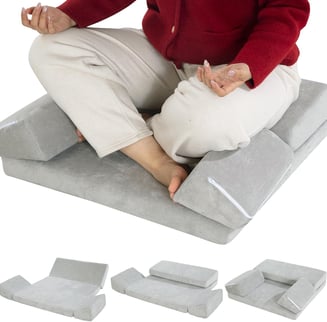10 Beginner-Friendly Meditation Techniques to Try at Home
11/1/20243 min read
Introduction
Starting a meditation practice can feel overwhelming with so many techniques available. Each style of meditation offers unique benefits, from stress relief to improved focus. Here are 10 beginner-friendly meditation techniques that can help you find peace, relax, and ease into a consistent meditation routine.


1. Breath Awareness Meditation
Breath awareness is one of the simplest meditation techniques and is ideal for beginners. By focusing on your natural breathing rhythm, you can calm the mind and bring your attention to the present moment.
How to Practice
Find a comfortable seated position.
Close your eyes and take a few deep breaths.
Focus on the sensation of your breath as it moves in and out.
2. Body Scan Meditation
Body scan meditation involves mentally scanning your body from head to toe, paying attention to areas of tension and relaxation. It’s excellent for relaxation and connecting with your body.
How to Practice
Lie down in a comfortable position.
Start by focusing on your toes and move upwards, noticing any sensations in each body part.
Release any tension as you progress up to your head.
3. Loving-Kindness Meditation (Metta)
This meditation technique helps cultivate compassion and empathy. By repeating positive phrases for yourself and others, you encourage a sense of goodwill.
How to Practice
Sit comfortably and silently repeat phrases like “May I be happy,” “May I be safe.”
Gradually extend these wishes to others, including friends, family, and even strangers.
4. Visualization Meditation
In visualization meditation, you create a mental image of a peaceful place, which can help calm the mind and uplift your mood.
How to Practice
Close your eyes and picture a serene place, like a beach or a forest.
Focus on the sensory details—sounds, sights, and scents—to immerse yourself.
5. Mantra Meditation
Mantra meditation uses a word or phrase, such as “peace” or “om,” repeated silently to focus the mind and create calm.
How to Practice
Find a comfortable seat, close your eyes, and start repeating your chosen word.
Allow the rhythm of the mantra to clear away distractions.
6. Mindfulness Meditation
Mindfulness meditation involves paying attention to your thoughts, feelings, and bodily sensations without judgment.
How to Practice
Sit in a quiet place and close your eyes.
Observe each thought or sensation as it arises, then let it go.


7. Walking Meditation
Walking meditation combines mindfulness with movement, ideal for those who prefer active meditation.
How to Practice
Walk slowly, paying attention to each step.
Notice the feeling of your feet on the ground and your breath as you walk.
8. Sound Meditation
Sound meditation involves focusing on sounds in your environment, such as nature sounds or a singing bowl, to deepen concentration and relaxation.
How to Practice
Close your eyes and focus on the ambient sounds.
Let each sound anchor your attention without trying to analyze it.
9. Counting Breath Meditation
Counting each breath is a simple way to keep your mind focused.
How to Practice
Breathe naturally and count each inhale and exhale from 1 to 10.
If your mind wanders, start the count over.
10. Guided Meditation
Guided meditation uses recorded instructions to lead you through a meditation.
How to Practice
Find a quiet space and choose a guided meditation video or app.
Let the guide’s voice direct your focus.
Conclusion
These techniques are easy ways to start your meditation journey at home. Try experimenting with each technique to find the one that resonates best with you. Regular practice can help bring calm, focus, and a sense of peace to your daily life.
Joy
Inspire your journey to happiness and fulfillment.
contact us
Growth
© 2024. All rights reserved.










